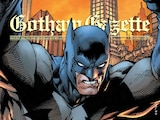There is no shortage of horror-tinged Batman stories, but the scariest ones involve his family. While Batman’s live action adaptations have largely stayed away from the Bat-Family, they are an integral part of his journey in comics. After all, Dick Grayson’s Robin was introduced in 1940, just a year after Batman was first created. For both characters and fans alike, Batman’s family is a source of comfort, a stabilizing force within the chaotic world of Gotham City. And it is precisely because of this that the Bat-Family can also be such a strong source of terror.
What makes something scary is subjective, but Batman’s vision of horror has a distinct existential quality to it. Frequently, these stories revolve around something familiar or innocuous being transformed into something monstrous. They transgress boundaries and, crucially for the Dark Knight, revoke his sense of control. For someone as methodical and committed to “prep time” as Batman, this loss of control is a nightmarish reminder of how he felt as a child, watching his parents get murdered in front of him. Thus, family is the source of Batman’s greatest fear, manifesting itself from his traumatic memories and shaping his behavior as a parent.

It’s no accident, then, that two of Batman’s most disturbing comic book stories are based around the horrors of having a family. In Scott Snyder, Greg Capullo and Jonathan Glapion’s Death of the Family, the Joker attacked Batman’s sense of safety by going after the Bat-Family—most principally, Nightwing, Red Hood, Red Robin, Barbara Gordon’s Batgirl and Robin.
What makes Batman and the Joker’s clash unique this time around is that the Joker tempts Batman with the idea that he can return back to good ol’ days when it was just the two of them. In Batman #17, the Joker muses that Batman secretly wants his children dead so he can fully commit himself to a life of crimefighting. To heighten the sense of terror, Batman awakes to find his family tied down to chairs at a dinner table, their faces bloody and bandaged. Joker says, “[The Bat-Family] makes[s] you everything you want to forget that you are, everything you’re afraid of. And you were afraid, when you took them in. I know. It’s okay, old friend. It was a moment of weaknesssss…”
While Batman, of course, chooses the Bat-Family over the Joker, Death of the Family raises a harrowing question of identity. Is Batman defined more by his relationship with criminals like the Joker, or by the young people he’s a father figure to? While the former makes him feel invincible, he can’t deny that being a parent can be utterly terrifying. Ultimately, Death of the Family proves that Batman is heroic because of his reckoning with parental anxieties. He is brave because he acknowledges his own fears. While he’s far from perfect, Death of the Family demonstrates why Bruce choosing parenthood for himself completes the meditation on fear and trauma that’s implicit to the Batman mantle.

Writer Scott Snyder also explored similar themes of horror and family earlier in The Black Mirror. With artists Francesco Francavilla and Jock, The Black Mirror followed Dick Grayson’s Batman as he faced his most disturbing villain yet: James Gordon Jr., the psychopathic son of Commissioner Gordon. The story is split between Dick gradually learning that he doesn’t know Gotham as well as he thinks he does, and Gordon reflecting on how a serial killer without empathy could have been raised in his own home. It exemplifies Batman’s brand of existential horror, as the story’s focus on family points to how evil can reside within all of us—even those who come from us.
The Black Mirror’s scares are driven partly by the story’s relation to one of the most popular Batman stories of all time: Batman: Year One by Frank Miller and David Mazzucchelli. Year One introduced James Gordon Jr. as a baby years before Snyder, Jock and Francavilla’s story brought him back as a violent killer. The Black Mirror provides an unsettling legacy for a beloved Batman story, one that had long been a familiar favorite to fans.
It works by using fans’ familiarity with Year One to reveal the horrifying truth lurking beneath family as an idea. The word “familiar” comes from the Latin familiaris, referring to the intimacy of “belonging to a family.” James Gordon Jr. works as a villain to highlight Batman’s themes of horror and family precisely because he is familiar. As The Black Mirror shows, what’s “familiar” may not be all that safe, or even knowable.

Part of what makes horror such an effective genre is because of its ability to convey truth. The mechanism underlying both Death of the Family and The Black Mirror’s scares is some fact that Batman doesn’t want to acknowledge. While Dick Grayson’s Batman was better in tune with his own emotional life, Bruce Wayne’s Batman is characterized by his immense sense of repression. Unfortunately, this repression and reluctance to face difficult truths provides constant fodder for his enemies.
Though Batman’s family has been a source of horror for him, they are ultimately what makes him stronger as a hero. The weight of being Batman is not one that should be carried alone. The Bat-Family is the tether that keeps Bruce Wayne’s humanity connected to his activities as Batman.
As long as he can keep them safe.
Batman: Death of the Family by Scott Snyder and Greg Capullo and Batman: The Black Mirror by Scott Snyder and Jock are both available as graphic novels in bookstores, comic shops and libraries and on DC UNIVERSE INFINITE.
Jules Chin Greene writes about comics for DC.com, and his work can also be found at Nerdist, Popverse and Multiverse of Color. You can follow him on Twitter and Bluesky at @JulesChinGreene.
NOTE: The views and opinions expressed in this feature are solely those of Jules Chin Greene and do not necessarily reflect those of DC Entertainment or Warner Bros., nor should they be read as confirmation or denial of future DC plans.















